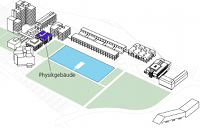Position Indication:
Content

2008 - Johannes Preiner
Fast Scanning AFM study of antibody-antigen binding dynamics on biological membranes
Dissertationsprojekt:
Forschungsaufenthalt am Toshio Biophysics-Institute at the Kanazawa University,
Kanazawa, Japan
22.10.2007 – 23.11.2007
Johannes Preiner
Contact: johannes.preiner(/\t)jku.at
Binding
geometry and structural changes invoked upon interaction between antibodies
and
membrane proteins are of considerable interest for a better understanding of
the mechanisms of underlying receptor recognition and therefore important i
n a
variety of biological processes such as cell signalling and transmembrane
signal transduction. The binding dynamics of the antibody-antigen interacti
on
is commonly expressed in kinetic parameters, on-rate and off-rate, usually
quantified in ensemble average techniques. Owing to the high flexibility of
the
Fab and Fc fragment
s, the
two Fab fragments of an antibody can bind
independently of each other. The kinetics of antibody binding to cell membr
ane
antigens is therefore determined by the inherent binding properties of the
Fab fragment-antigen interaction, the flexibility and
movement of the antibody molecule, and the lateral arrangement and mobility
of
the antigenic binding sites.
The
new Fast Scanning AFM developed by Toshio Ando (1-3) opens the possibility
to
observe the binding of antibodies with a high spatial resolution, and
additionally a video rate- time resolution (~60 frames per second), i.e. one
can follow the binding in realtime (so far,
conventional AFM images were taken in the time-scale of minutes).
During
my stay in this lab, binding studies of IgG
antibodies and other ligands on bacterial membr
anes
were performed using this new technique. The results revealed a highly dyna
mic
nature of all the samples investigated. In this way, diffusion of single
membrane proteins within a lipid bilayer (PM),
and
the dynamic behaviour of single proteins arranged in two dimensional
protein-lattices (S-layer) could be observed with sub-
nanometer
spatial and ~50 ms time resolution. The experiments revealed propagation of
defects, rotations of unit cells and the flexibility of single sub-domains,
which
are important processes considering the self-assembling properties of these
membranes. In addition, the dynamic behaviour of IgG
span>
antibodies upon binding to antigenic bindings sites embedded in membranes h
ave
been observed for the very first time, and a qualitative explanation of the
origin of this dynamics could be given. Experiments involving ligands with other mechanical properties than IgGs, like Fab fragments
of the
very same antibodies and StrepTactin, were performed, supporting the given
qualitative picture.
In
conclusion, novel insights into the dynamic behaviour of various biological
samples were gained, which would not have been possible with any commercial
ly
available technique. From the scientific point of view, my stay in


 Audit hochschule und familie
Audit hochschule und familie

